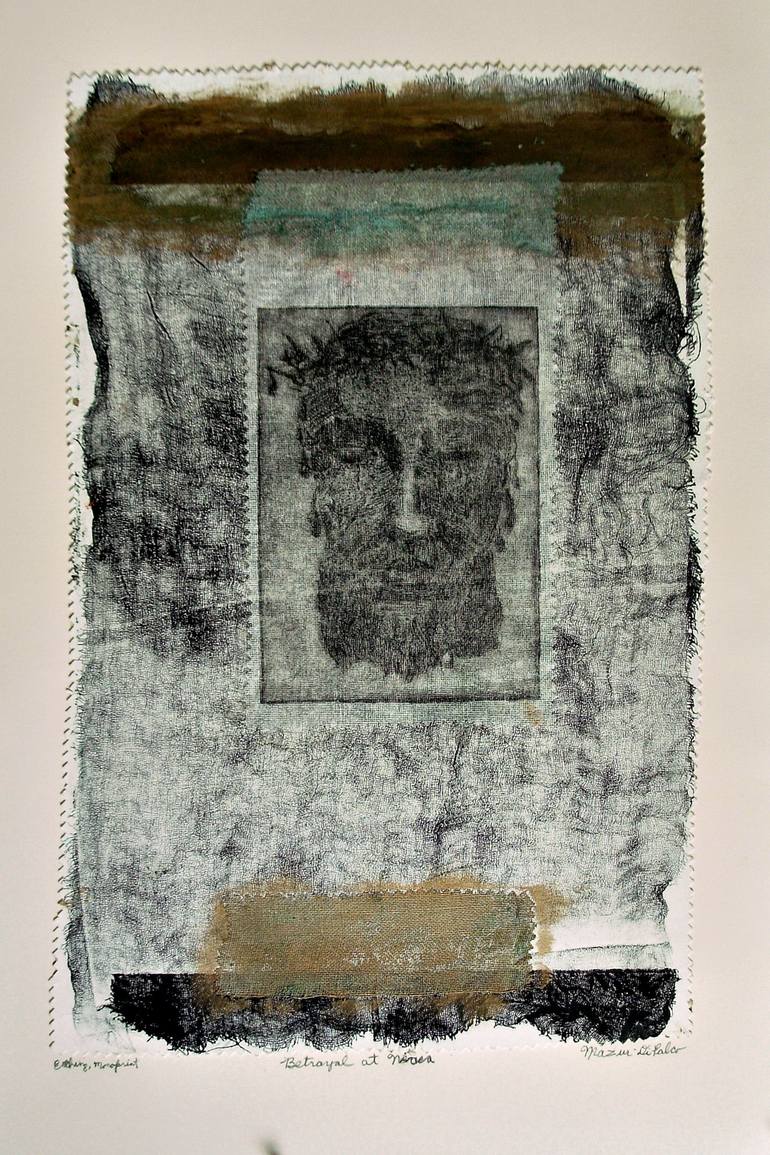


VIEW IN MY ROOM
Betrayal at Niceae - Limited Edition of 1 Print
United States
Printmaking, Etching on Paper
Size: 15 W x 22 H x 0.2 D in
Ships in a Box
Artist Recognition

Artist featured in a collection
About The Artwork
Jerry Mazur-DiFalco created this original, one of a kind mixed media work while suffering from the extreme pain of spinal deformity and full body arthritis. It depicts the unending and throbbing pain of chaos via the image of a reference to Veronica’s Veil. This veil relates to the crucifixion of Christ, when a woman named Veronica wipe the blood from Jesus’ face; consequently, an image of his face is transferred to her veil. The media include tarlatan, blotter paper, RivesBFK cream paper, gloss acrylic gels, and colored etching inks from Paris. The overall size is about fifteen inches wide by twenty-two inches high. In order to keep the price low and give the collector a wide rage of framing choices, the artwork ships without a mat of frame. It ships between two archival papers and boards, wrapped in a weather proofing plastic. Shipment box and bubble wraps are included along with a Certificate of Authenticity. The title refers to all of the cover-ups resulting about Christ's teachings that emerged from The Council of Niceae. The Early Christian Church was quite diversified and the philosophies numerous. In an effort to "unify" the community, old church leaders, all men, met at Niceae and drafted The Apostle's Creed, which negated close to 75% of what the Early Christian Church represented. The reference to the artist's physical pain from his deformed spine is transferred to this horrible "mistake" of non-inclusion by the "OLD WHITE BOYS NETWORK". Gnostics were but one group to be erased from the Christian community in 325 C.E. Female priests and Bishops were also banned . . . along with any group that deviated from the new "established" Creed. Dialogue was,in effect, silenced by this Council of Repression.
Details & Dimensions
Printmaking:Etching on Paper
Original:One-of-a-kind Artwork
Size:15 W x 22 H x 0.2 D in
Frame:Not Framed
Ready to Hang:Not applicable
Packaging:Ships in a Box
Shipping & Returns
Delivery Time:Typically 5-7 business days for domestic shipments, 10-14 business days for international shipments.
Handling:Ships in a box. Artists are responsible for packaging and adhering to Saatchi Art’s packaging guidelines.
Ships From:United States.
Have additional questions?
Please visit our help section or contact us.
United States
Imagery and storyline—both vital components of my creative process—enable me to create a form of visual poetry. Consequently, photography is intricate to my artistic strategy, especially with regard to my etchings. In view of this, many of my printed images—accomplished via the studio techniques of intaglio, aquatint, drypoint, and Chine collè—originate from my own photographs, as well as ones I uncover during research into the archives of academia, historical societies, and museums. Upon locating a scene that fascinates me, I first sketch a few original drawings of the likeness, and next transfer that drawing onto my prepared zinc etching plate. NOTE: In my etchings that incorporate the Chine collè process, I use mulberry bark paper from Thailand, which is infused with Japanese kozo threads. The paper is also treated with methylcellulose. I endeavor to establish links between the metaphysical and physical worlds . . . between the realms of dream and reality . . . and between the natural and the fabricated. In a sense, I believe that art unveils everything that we mask behind our assumptions and biases . . . or rather, those realms we neglect—or refuse—to perceive. My label for our failure to examine these areas is, “The Phenomenology of Non-Connectedness", which I blame on today’s communicational tools such as Social Media, the Internet, texting on smart phones, and “tweeting”. MY ETCHING TECHNIQUE I work on metal etching plates treated with both hard and soft grounds. These grounds consist of mineral spirits, beeswax, oil of spike lavender, and other natural substances. After these grounds dry, I draw images with needles and other tools onto the plate. Next, the exposed areas are “etched into” the zinc or copper plate in a bath of Nitric Acid and spring water. An artist’s proof in then printed after the plate is cleaned; Moreover, two to seven additional plate workings, acid baths, and proof printings occur before my desired effect is obtained. When satisfied with my end result, I apply oil based etching ink onto the clean plate and then remove the excess ink with several wipes. Next, I align my etching plate onto the printing press bed and cover it with papers and press blankets. Finally, the plate goes through the press to obtain my print. This process is repeated until all editions are created. I usually create three to five editions of five or six etchings for each one of my plates.
Artist Recognition

Artist featured by Saatchi Art in a collection
Thousands Of Five-Star Reviews
We deliver world-class customer service to all of our art buyers.
Global Selection
Explore an unparalleled artwork selection by artists from around the world.
Satisfaction Guaranteed
Our 14-day satisfaction guarantee allows you to buy with confidence.
Support An Artist With Every Purchase
We pay our artists more on every sale than other galleries.
Need More Help?